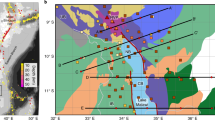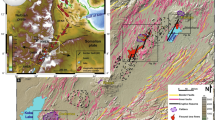Abstract
In many highly extended rifts on the Earth, tectonic removal of the upper crust exhumes mid-crustal rocks, producing metamorphic core complexes. These structures allow the upper continental crust to accommodate tens of kilometres of extension1, but it is not clear how the lower crust and underlying mantle respond. Also, despite removal of the upper crust, such core complexes remain both topographically high and in isostatic equilibrium. Because many core complexes in the western United States are underlain by a flat Moho discontinuity2,3, it has been widely assumed that their elevation is supported by flow in the lower crust4,5,6 or by magmatic underplating7. These processes should decouple upper-crust extension from that in the mantle. In contrast, here we present seismic observations of metamorphic core complexes of the western Woodlark rift that show the overall crust to be thinned beneath regions of greatest surface extension. These core complexes are actively being exhumed8 at a rate of 5–10 km Myr-1, and the thinning of the underlying crust appears to be compensated by mantle rocks of anomalously low density, as indicated by low seismic velocities. We conclude that, at least in this case, the development of metamorphic core complexes and the accommodation of high extension is not purely a crustal phenomenon, but must involve mantle extension.
This is a preview of subscription content, access via your institution
Access options
Subscribe to this journal
Receive 51 print issues and online access
$199.00 per year
only $3.90 per issue
Buy this article
- Purchase on Springer Link
- Instant access to full article PDF
Prices may be subject to local taxes which are calculated during checkout




Similar content being viewed by others
References
Lister, G. S. & Davis, G. A. The origin of metamorphic core complexes and detachment faults formed during Tertiary continental extension in the northern Colorado River region, U.S.A. J. Struct. Geol. 11, 65–94 (1989)
Klemperer, S. L., Hauge, T. A., Hauser, E. C., Oliver, J. E. & Potter, C. J. The Moho in the northern Basin and Range Province, Nevada, along the COCORP 40 degrees N seismic-reflection transect. Geol. Soc. Am. Bull. 97, 603–618 (1986)
McCarthy, J., Larkin, S. P., Fuis, G. S., Simpson, R. W. & Howard, K. A. Anatomy of a metamorphic core complex; seismic refraction/wide-angle reflection profiling in southeastern California and western Arizona. J. Geophys. Res. 96, 12259–12291 (1991)
Block, L. & Royden, L. H. Core complex geometries and regional scale flow in the lower crust. Tectonics 9, 557–567 (1990)
Kruse, S., McNutt, M., Phipps-Morgan, J., Royden, L. & Wernicke, B. Lithospheric extension near Lake Mead: A model for ductile flow in the lower crust. J. Geophys. Res. 96, 4435–4456 (1991)
McKenzie, D., Nimmo, F., Jackson, J. A., Gans, P. B. & Miller, E. L. Characteristics and consequences of flow in the lower crust. J. Geophys. Res. 105, 11029–11046 (2000)
Lister, G. S. & Baldwin, S. L. Plutonism and the origin of metamorphic core complexes. Geology 21, 607–610 (1993)
Davies, H. L. & Warren, R. G. Origin of eclogite-bearing, domed, layered metamorphic complexes (“core complexes”) in the D'Entrecasteaux Islands, Papua New Guinea. Tectonics 7, 1–21 (1988)
Abers, G. A. in Non-Volcanic Rifting of Continental Margins: Comparison of Evidence from Land and Sea (eds Wilson, R. C. L., Whitmarsh, R. B., Taylor, B. & Froitzheim, N.) 305–318 (Geological Society, London, 2001)
Taylor, B., Goodliffe, A. M. & Martinez, F. How continents break up: Insights from Papua New Guinea. J. Geophys. Res. 104, 7497–7512 (1999)
Weissel, J. K., Taylor, B. & Karner, G. D. The opening of the Woodlark Basin, subduction of the Woodlark spreading system, and the evolution of northern Melanesia since mid-Pliocene time. Tectonophysics 87, 253–277 (1982)
Ruppel, C. Extensional processes in continental lithosphere. J. Geophys. Res. 100, 24187–24215 (1995)
Nyblade, A. A., Owens, T. J., Gurrola, H., Ritsema, J. & Langston, C. A. Seismic evidence for a deep mantle thermal anomaly beneath east Africa. Geology 28, 599–602 (2000)
Baldwin, S. L., Lister, G. S., Hill, E. J., Foster, D. A. & McDougall, I. Thermochronologic constraints on the tectonic evolution of active metamorphic core complexes, D'Entrecasteaux Islands, Papua New Guinea. Tectonics 12, 611–628 (1993)
Hill, E. J. & Baldwin, S. L. Exhumation of high pressure metamorphic rocks during crustal extension in the D'Entrecasteaux Islands, Papua New Guinea. J. Metamorph. Geol. 11, 261–277 (1993)
Ollier, C. D. & Pain, C. F. Active rising surficial gneiss domes in Papua New Guinea. J. Geol. Soc. Aust. 27, 33–44 (1980)
Owens, T. J., Zandt, G. & Taylor, S. R. Seismic evidence for an ancient rift beneath the Cumberland Plateau, TN: a detailed analysis of broadband teleseismic P-waveforms. J. Geophys. Res. 89, 7783–7795 (1984)
Karato, S. Importance of anelasticity in the interpretation of seismic tomography. Geophys. Res. Lett. 20, 1623–1626 (1993)
Smith, I. E. in Volcanism in Australasia (ed. Johnson, R. W.) 275–286 (Elsevier, New York, 1976)
Martinez, F., Goodliffe, A. M. & Taylor, B. Metamorphic core complex formation by density inversion and lower-crust extrusion. Nature 411, 930–934 (2001)
Achauer, U. et al. New ideas on the Kenya rift based on the inversion of the combined dataset of the 1985 and 1989/1990 seismic tomography experiments. Tectonophysics 238, 305–329 (1994)
Toomey, D. R., Wilcock, W. S., Solomon, S. C., Hammond, W. C. & Orcutt, J. A. Mantle seismic structure beneath the MELT region of the East Pacific Rise from P and S wave tomography. Science 280, 1224–1227 (1998)
McKenzie, D. & Bickle, M. J. The volume and composition of melt generated by extension of lithosphere. J. Petrol. 29, 625–679 (1988)
Hill, E. J., Baldwin, S. L. & Lister, G. S. Magmatism as an essential driving force for formation of active metamorphic core complexes in eastern Papua New Guinea. J. Geophys. Res. 100, 10441–10451 (1995)
Buck, W. R. & Su, W. Focused mantle upwelling below mid-ocean ridges due to feedback between viscosity and melting. Geophys. Res. Lett. 16, 641–644 (1989)
Sheehan, A. F., Abers, G. A., Jones, C. H. & Lerner-Lam, A. L. Crustal thickness variations across the Colorado Rocky Mountains from teleseismic receiver functions. J. Geophys. Res. 100, 20391–20404 (1995)
Roecker, S. W. in Seismic Tomography Theory and Practice (eds Iyer, H. M. & Hirahara, K.) 534–611 (Chapman and Hall, London, 1993)
Pinchin, J. & Bembrick, C. Cape Vogel Basin, PNG—tectonics and petroleum potential. Bur. Min. Resour. Aust. Rec. 32, 31–37 (1985)
Hacker, B. R., Abers, G. A. & Peacock, S. M. Subduction factory 1: Theoretical mineralogy, density, seismic wavespeeds, and H2O content. J. Geophys. Res. (in the press)
McKenzie, D. P. Some remarks on the development of sedimentary basins. Earth Planet. Sci. Lett. 40, 25–32 (1978)
Acknowledgements
The field effort in PNG would not have been successful without the efforts of S. Sioni, University of Papua New Guinea, J. Dickson, H. Sailasa and others of the Milne Bay Provincial Administration, PNG, and sub-district administrators throughout the province. Instruments and technical assistance were made available through the IRIS PASSCAL Instrument Center. The Geological Survey of Papua New Guinea gave permission to publish the gravity data on Fig. 4. We thank C. Ruppel for comments. This work was supported by the Geosciences Directorate of the National Science Foundation.
Author information
Authors and Affiliations
Corresponding author
Ethics declarations
Competing interests
The authors declare that they have no competing financial interests.
Supplementary information
Rights and permissions
About this article
Cite this article
Abers, G., Ferris, A., Craig, M. et al. Mantle compensation of active metamorphic core complexes at Woodlark rift in Papua New Guinea. Nature 418, 862–865 (2002). https://doi.org/10.1038/nature00990
Received:
Accepted:
Issue Date:
DOI: https://doi.org/10.1038/nature00990
This article is cited by
-
Dueling dynamics of low-angle normal fault rupture with splay faulting and off-fault damage
Nature Communications (2023)
-
Teleseismic P-Wave Tomography of the New Guinea-Solomon Arc System
Journal of Ocean University of China (2022)
-
Identification and localization of Nup170 in the microsporidian Nosema bombycis
Parasitology Research (2021)
-
The exhumation along the Kenyase and Ketesso shear zones in the Sefwi terrane, West African Craton: a numerical study
Geosciences Journal (2019)
-
Pliocene eclogite exhumation at plate tectonic rates in eastern Papua New Guinea
Nature (2004)
Comments
By submitting a comment you agree to abide by our Terms and Community Guidelines. If you find something abusive or that does not comply with our terms or guidelines please flag it as inappropriate.



